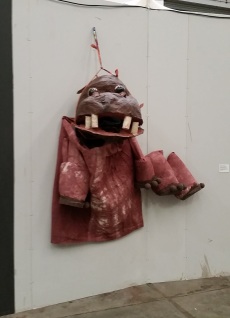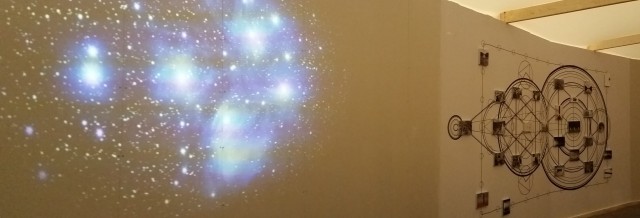The Cains Brewery, Stanhope Street (off Parliament Street), until 16th October, free.

Hippopotamus costume on display in the ‘Children’s Episode’
I need to start this post by going backwards, because in Edition 1 I forgot to explain something important about year’s Biennial. Which is that the whole show is structured as six ‘Episodes’ based on Liverpool’s past, present and future. These ‘Episodes’ are:
- Ancient Greece
- China Town
- Children’s Episode
- Monuments from the Future
- Flashback
- Software
Most of the artworks are linked to one particular ‘Episode’, but in the Cains Brewery several are brought together. Furthermore, many of the artists featured here also have works in other Biennial spaces – indeed, in the case of Oliver Laric’s Sleeping Shepherd Boy, an identical piece. Sounds confusing? I think it’s good curation. We’re so used to galleries putting together exhibitions of work by a single artist, it’s easy to ignore how the influences and intentions an artist have for their work can be part of a wider dialogue.
The more I think about it, the more these ‘Episodes’ make sense as the best way to discuss what’s here. Because some of this work is challenging and struck me as material to raise the question “is that really art?”. Which is what I constantly strive to answer with this blog.
Here are some of the things I enjoyed the most in this space.
The centre of the room is occupied by a structure called Collider. This creates a space which is used to divide the huge room into 3 episodes, of which the outer one (so the first you see) is ‘Chinatown’. The word makes me think of a place both integrated into and yet ‘apart’ from the rest of the city, and the artworks here all question a sense of belonging.

Love Trap
Some of the most strange and memorable works I have come across at the Biennial so far have been made by a group of 3 artists: Ramin Haerizadeh, Rokni Haerizadeh and Hesam Rahmanian. Living and working in Dubai, the artists have smuggled everything you see before you here today over for the exhibition, in part to raise questions about the value of art (which must seem particularly relevant when you’ve been exiled from your home nation for what you do). They have produced art in many mediums – painting, sculpture, video – and some of the works have apparently been made on site. I’d already seen some of their sculptures in the ABC Cinema, and some of the works here are equally as strange, amusing, and fit this episode well.
For where, exactly, do these “fish out of water” belong? Looking at Love Trap or the neighbouring King Above Us All, they clearly disrupt the normal visual language we use to depict these subjects. By making us ask “what is it?”, it helps us to accept the possibility of alternative ways of thinking. Just as, maybe, the foundation of Chinatown in 1834 in the heart of Liverpool did.
Moving inside the Collider to the ‘Flashback’ episode, and there’s a couple of things in here that I particularly like. One is a sequence of Rita McBride’s Perfiles; the Aqueduct of Adrian. Outlines of landmarks of Pompeii, they stand as symbols of something lost. Meanwhile on the wall, seemingly unrelated images are brought together in one part of Yin-Ju Chen’s Extrastellar Evaluations. Telling the story of the Lemurian civilization, it records a history which is both familiar and strange. The story is continued in a side room of the brewery, which has more feel of a historical museum than an art installation, and at FACT, which I haven’t visited yet but will have to explore.

Part of Yin-Ju Chen’s Extrastellar Evaluations
Collider’s central space is dedicated to the ‘Children’s Episode’ and built around the film Dogsy Ma Bone by Marvin Gaye Chetwynd. This film is apparently based on the idea that children’s understanding of reality is somewhat different to ours. I was initially sceptical of this – from ‘The Day Job’ I have enough experience of children (indeed, some of the children in this very film) to feel that they are not as naive as the description suggests. But maybe I’m lucky that it’s so commonplace for me to experience how groups of children think. It wouldn’t be a big step for me (more like part of the job) to “become” the hippopotamus whose costume hangs on the wall. Maybe for other people – maybe for you – this chance to reconnect with this childishness is a refreshment.
Liverpool Biennial is a contemporary art festival, and much contemporary art likes to make you think. Not tell you what to think, as the painters of the 19th century Salon did, but to make you think in new ways. I have only talked about a few of the artworks on display here, the ones I found most engaging. Maybe you will go along and find that you prefer others. But I would strongly encourage you to go along and think about it for yourself.

1 thought on “Liverpool Biennial Edition 2, Cains Brewery: Stories of the old and new”